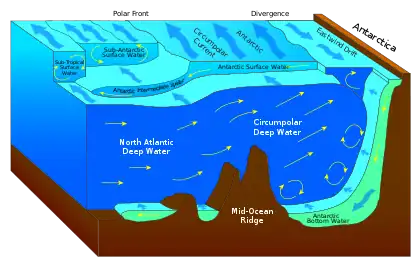Ocean temperature
Several factors cause the ocean temperature to vary. These are depth, geographical location and season. Both the temperature and salinity of ocean water differ. Warm surface water is generally saltier than the cooler deep or polar waters.[1] In polar regions, the upper layers of ocean water are cold and fresh.[2] Deep ocean water is cold, salty water found deep below the surface of Earth's oceans. This water has a uniform temperature of around 0-3 °C.[3] The ocean temperature also depends on the amount of solar radiation falling on its surface. In the tropics, with the Sun nearly overhead, the temperature of the surface layers can rise to over 30 °C (86 °F). Near the poles the temperature in equilibrium with the sea ice is about −2 °C (28 °F). There is a continuous circulation of water in the oceans. Thermohaline circulation (THC) is part of the large-scale ocean circulation. It is driven by global density gradients created by surface heat and freshwater fluxes.[4][5] Warm surface currents cool as they move away from the tropics. This happens as the water becomes denser and sinks. Changes in temperature and density move the cold water back towards the equator as a deep sea current. Then it eventually wells up again towards the surface.
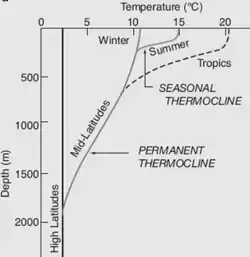
Ocean temperature as a term applies to the temperature in the ocean at any depth. It can also apply specifically to the ocean temperatures that are not near the surface. In this case it is synonymous with "deep ocean temperature").
It is clear that the oceans are warming as a result of climate change and this rate of warming is increasing.[6]: 9 [7] The upper ocean (above 700 m) is warming fastest, but the warming trend extends throughout the ocean. In 2022, the global ocean was the hottest ever recorded by humans.[8]
Definition and types
Sea surface temperature
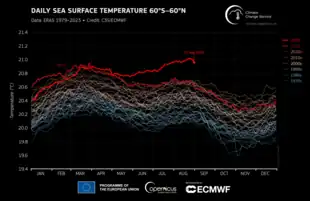
Deep ocean temperature
Experts refer to the temperature further below the surface as "ocean temperature" or "deep ocean temperature". Ocean temperatures more than 20 metres below the surface vary by region and time. They contribute to variations in ocean heat content and ocean stratification.[10] The increase of both ocean surface temperature and deeper ocean temperature is an important effect of climate change on oceans.[10]
Deep ocean water is the name for cold, salty water found deep below the surface of Earth's oceans. Deep ocean water makes up about 90% of the volume of the oceans. Deep ocean water has a very uniform temperature of around 0-3 °C. Its salinity is about 3.5% or 35 ppt (parts per thousand).[3]
Relevance
Ocean temperature and dissolved oxygen concentrations have a big influence on many aspects of the ocean. These two key parameters affect the ocean's primary productivity, the oceanic carbon cycle, nutrient cycles, and marine ecosystems.[11] They work in conjunction with salinity and density to control a range of processes. These include mixing versus stratification, ocean currents and the thermohaline circulation.
Ocean heat content
Experts calculate ocean heat content by using ocean temperatures at different depths.
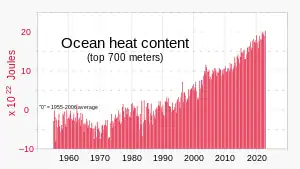
Ocean heat content (OHC) is the energy absorbed and stored by oceans. To calculate the ocean heat content, it is necessary to measure ocean temperature at many different locations and depths. Integrating the areal density of ocean heat over an ocean basin or entire ocean gives the total ocean heat content.[13] Between 1971 and 2018, the rise in ocean heat content accounted for over 90% of Earth’s excess thermal energy from global heating.[14][15] The main driver of this increase was anthropogenic forcing via rising greenhouse gas emissions.[16]: 1228 By 2020, about one third of the added energy had propagated to depths below 700 meters.[17][18] In 2022, the world’s oceans were again the hottest in the historical record and exceeded the previous 2021 record maximum.[19] The four highest ocean heat observations occurred in the period 2019–2022. The North Pacific, North Atlantic, the Mediterranean, and the Southern Ocean all recorded their highest heat observations for more than sixty years.[20] Ocean heat content and sea level rise are important indicators of climate change.[21]
Ocean water absorbs solar energy efficiently. It has far greater heat capacity than atmospheric gases.[17] As a result, the top few meters of the ocean contain more thermal energy than the entire Earth's atmosphere.[22] Since before 1960, research vessels and stations have sampled sea surface temperatures and temperatures at greater depth all over the world. Since 2000, an expanding network of nearly 4000 Argo robotic floats has measured temperature anomalies, or the change in ocean heat content. Ocean heat content has been increasing at a steady or accelerating rate since at least 1990.[14][23] The net rate of change in the upper 2000 meters from 2003 to 2018 was +0.58±0.08 W/m2 (or annual mean energy gain of 9.3 zettajoules). It is challenging to measure temperatures over decades with sufficient accuracy and covering enough areas. This gives rise to the uncertainty in the figures.[21]Measurements
There are various ways to measure ocean temperature.[24] Below the sea surface, it is important to refer to the specific depth of measurement as well as measuring the general temperature. The reason is there is a lot of variation with depths. This is especially the case during the day. At this time low wind speed and a lot of sunshine may lead to the formation of a warm layer at the ocean surface and big changes in temperature as you get deeper. Experts call these strong daytime vertical temperature gradients a diurnal thermocline.[25]
The basic technique involves lowering a device to measure temperature and other parameters electronically. This device is called CTD which stands for conductivity, temperature, and depth.[26] It continuously sends the data up to the ship via a conducting cable. This device is usually mounted on a frame that includes water sampling bottles. Since the 2010s autonomous vehicles such as gliders or mini-submersibles have been increasingly available. They carry the same CTD sensors, but operate independently of a research ship.
Scientists can deploy CTD systems from research ships on moorings gliders and even on seals.[27] With research ships they receive data through the conducting cable. For the other methods they use telemetry.
There are other ways of measuring sea surface temperature.[28] At this near-surface layer measurements are possible using thermometers or satellites with spectroscopy. Weather satellites have been available to determine this parameter since 1967. Scientists created the first global composites during 1970.[29]
The Advanced Very High Resolution Radiometer (AVHRR) is widely used to measure sea surface temperature from space.[24]: 90
There are various devices to measure ocean temperatures at different depths. These include the Nansen bottle, bathythermograph, CTD, or ocean acoustic tomography. Moored and drifting buoys also measure sea surface temperatures. Examples are those deployed by the Global Drifter Program and the National Data Buoy Center. The World Ocean Database Project is the largest database for temperature profiles from all of the world’s oceans.[30]
A small test fleet of "deep Argo" floats aims to extend the measurement capability down to about 6000 meters. It will accurately sample temperature for a majority of the ocean volume once it is in full use.[31][32]
Mercury thermometers
The most frequent measurement technique on ships and buoys is thermistors and mercury thermometers.[24]: 88 Scientists often use mercury thermometers to measure the temperature of surface waters. They can put them in buckets dropped over the side of a ship. To measure deeper temperatures they put them on Nansen bottles.[24]: 88
Argo program
Ocean warming
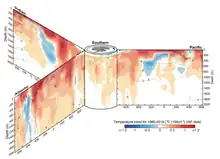
Trends
It is clear that the ocean is warming as a result of climate change, and this rate of warming is increasing.[36]: 9 The global ocean was the warmest it had ever been recorded by humans in 2022.[37] This is determined by the ocean heat content, which exceeded the previous 2021 maximum in 2022.[37] The steady rise in ocean temperatures is an unavoidable result of the Earth's energy imbalance, which is primarily caused by rising levels of greenhouse gases.[37] Between pre-industrial times and the 2011–2020 decade, the ocean's surface has heated between 0.68 and 1.01 °C.[38]: 1214
The upper ocean (above 700 m) is warming the fastest, but the warming trend is widespread. The majority of ocean heat gain occurs in the Southern Ocean. For example, between the 1950s and the 1980s, the temperature of the Antarctic Southern Ocean rose by 0.17 °C (0.31 °F), nearly twice the rate of the global ocean.[39]
The warming rate varies with depth: at a depth of a thousand metres the warming occurs at a rate of nearly 0.4 °C per century (data from 1981 to 2019), whereas warming occurs at only half that depth.[40]: 463Causes
The root cause of these observed changes is the warming of the Earth due to emissions of greenhouse gases from human causes. These gases include carbon dioxide and methane.[42] The ocean takes up most of the additional heat in the climate system.[7] So this results in ocean warming.
We can express this in another way. The climb in ocean temperatures is the inevitable outcome of Earth's energy imbalance. And this imbalance comes with increasing concentrations of greenhouse gases.[8]
Increased stratification and lower oxygen levels
Higher air temperatures warm the ocean surface. And this leads to greater ocean stratification. Reduced mixing of the ocean layers stabilises warm water near the surface. At the same time it reduces cold, deep water circulation. The reduced up and down mixing reduces the ability of the ocean to absorb heat. This directs a larger fraction of future warming toward the atmosphere and land. Energy available for tropical cyclones and other storms is likely to increase. Nutrients for fish in the upper ocean layers are set to decrease. This is also like to reduce the capacity of the oceans to store carbon.
Warmer water cannot contain as much oxygen as cold water. Increased thermal stratification may reduce the supply of oxygen from the surface waters to deeper waters. This would further decrease the water's oxygen content.[43] This process is called ocean deoxygenation. The ocean has already lost oxygen throughout the water column. Oxygen minimum zones are expanding worldwide.[44]: 471
Changing ocean currents
Varying temperatures associated with sunlight and air temperatures at different latitudes cause ocean currents. Prevailing winds and the different densities of saline and fresh water are another cause of currents. Air tends to be warmed and thus rise near the equator, then cool and thus sink slightly further poleward. Near the poles, cool air sinks, but is warmed and rises as it then travels along the surface equatorward. The sinking and upwelling that occur in lower latitudes, and the driving force of the winds on surface water, mean the ocean currents circulate water throughout the entire sea. Global warming on top of these processes causes changes to currents, especially in the regions where deep water is formed.[45]
In the geologic past
Scientists believe the sea temperature was much hotter in the Precambrian period. Such temperature reconstructions derive from oxygen and silicon isotopes from rock samples.[46][47] These reconstructdions suggest the ocean had a temperature of 55–85 °C 2,000 to 3,500 million years ago. It then cooled to milder temperatures of between 10 and 40 °C by 1,000 million years ago. Reconstructed proteins from Precambrian organisms also provide evidence that the ancient world was much warmer than today.[48][49]
The Cambrian Explosion approximately 538.8 million years ago was a key event in the evolution of life on Earth. This event took place at a time when scientists believe sea surface temperatures reached about 60 °C.[50] Such high temperatures are above the upper thermal limit of 38 °C for modern marine invertebrates. They preclude a major biological revolution.[51]
During the later Cretaceous period, from 100 to 66 million years ago, average global temperatures reached their highest level in the last 200 million years or so.[52] This was probably the result of the configuration of the continents during this period. It allowed for improved circulation in the oceans. This discouraged the formation of large scale ice sheet.
Data from an oxygen isotope database indicate that there have been seven global warming events during the geologic past. These include the Late Cambrian, Early Triassic, Late Cretaceous, and Paleocene-Eocene transition. The surface of the sea was about 5-30º warmer than today in these warming period.[11]
See also
- Ocean current § Causes, temperature as a contributing cause of ocean currents
- Global surface temperature, a planet-wide average of temperatures at both the sea surface and the air over land
- Marine heatwave
- Upwelling
References
- "Ocean Stratification". The Climate System. Columbia Univ. Archived from the original on 29 March 2020. Retrieved 22 September 2015.
- "The Hidden Meltdown of Greenland". Nasa Science/Science News. NASA. Retrieved 23 September 2015.
- "Temperature of Ocean Water". UCAR. Archived from the original on 2010-03-27. Retrieved 2012-09-05.
- Rahmstorf, S (2003). "The concept of the thermohaline circulation" (PDF). Nature. 421 (6924): 699. Bibcode:2003Natur.421..699R. doi:10.1038/421699a. PMID 12610602. S2CID 4414604.
- Lappo, SS (1984). "On reason of the northward heat advection across the Equator in the South Pacific and Atlantic ocean". Study of Ocean and Atmosphere Interaction Processes. Moscow Department of Gidrometeoizdat (in Mandarin): 125–9.
- IPCC, 2019: Summary for Policymakers Archived 2022-10-18 at the Wayback Machine. In: IPCC Special Report on the Ocean and Cryosphere in a Changing Climate Archived 2021-07-12 at the Wayback Machine [H.-O. Pörtner, D.C. Roberts, V. Masson-Delmotte, P. Zhai, M. Tignor, E. Poloczanska, K. Mintenbeck, A. Alegría, M. Nicolai, A. Okem, J. Petzold, B. Rama, N.M. Weyer (eds.)]. Cambridge University Press, Cambridge, UK and New York, NY, USA. https://doi.org/10.1017/9781009157964.001.
- Cheng, Lijing; Abraham, John; Hausfather, Zeke; Trenberth, Kevin E. (2019). "How fast are the oceans warming?". Science. 363 (6423): 128–129. Bibcode:2019Sci...363..128C. doi:10.1126/science.aav7619. ISSN 0036-8075. PMID 30630919. S2CID 57825894.
- Cheng, Lijing; Abraham, John; Trenberth, Kevin E.; Fasullo, John; Boyer, Tim; Mann, Michael E.; Zhu, Jiang; Wang, Fan; Locarnini, Ricardo; Li, Yuanlong; Zhang, Bin; Yu, Fujiang; Wan, Liying; Chen, Xingrong; Feng, Licheng (2023). "Another Year of Record Heat for the Oceans". Advances in Atmospheric Sciences. 40 (6): 963–974. doi:10.1007/s00376-023-2385-2. ISSN 0256-1530. PMC 9832248. PMID 36643611.
 Text was copied from this source, which is available under a Creative Commons Attribution 4.0 International License
Text was copied from this source, which is available under a Creative Commons Attribution 4.0 International License - McCarthy, Gerard D.; Haigh, Ivan D.; Hirschi, Joël J.-M.; Grist, Jeremy P.; Smeed, David A. (2015-05-28). "Ocean impact on decadal Atlantic climate variability revealed by sea-level observations" (PDF). Nature. 521 (7553): 508–510. Bibcode:2015Natur.521..508M. doi:10.1038/nature14491. ISSN 1476-4687. PMID 26017453. S2CID 4399436.
- Fox-Kemper, B., H.T. Hewitt, C. Xiao, G. Aðalgeirsdóttir, S.S. Drijfhout, T.L. Edwards, N.R. Golledge, M. Hemer, R.E. Kopp, G. Krinner, A. Mix, D. Notz, S. Nowicki, I.S. Nurhati, L. Ruiz, J.-B. Sallée, A.B.A. Slangen, and Y. Yu, 2021: Chapter 9: Ocean, Cryosphere and Sea Level Change Archived 2022-10-24 at the Wayback Machine. In Climate Change 2021: The Physical Science Basis. Contribution of Working Group I to the Sixth Assessment Report of the Intergovernmental Panel on Climate Change Archived 2021-08-09 at the Wayback Machine [Masson-Delmotte, V., P. Zhai, A. Pirani, S.L. Connors, C. Péan, S. Berger, N. Caud, Y. Chen, L. Goldfarb, M.I. Gomis, M. Huang, K. Leitzell, E. Lonnoy, J.B.R. Matthews, T.K. Maycock, T. Waterfield, O. Yelekçi, R. Yu, and B. Zhou (eds.)]. Cambridge University Press, Cambridge, United Kingdom and New York, NY, USA, pp. 1211–1362, doi:10.1017/9781009157896.011.
- Song, Haijun; Wignall, Paul B.; Song, Huyue; Dai, Xu; Chu, Daoliang (2019). "Seawater Temperature and Dissolved Oxygen over the Past 500 Million Years". Journal of Earth Science. 30 (2): 236–243. doi:10.1007/s12583-018-1002-2. ISSN 1674-487X. S2CID 146378272.
- Lindsey, Rebecca; Dahlman, Luann (17 August 2020). "Climate Change: Ocean Heat Content". climate.gov. National Oceanic and Atmospheric Administration (NOAA). Archived from the original on 25 February 2023. Embedded data link downloads data that is more current than 2020 publication date of article.
- Kumar, M. Suresh; Kumar, A. Senthil; Ali, MM (10 December 2014). "Computation of Ocean Heat Content" (PDF). Technical Report NRSC-SDAPSA-G&SPG-DEC-2014-TR-672. National Remote Sensing Centre (ISRO), Government of India.
- von Schuckman, K.; Cheng, L.; Palmer, M. D.; Hansen, J.; et al. (7 September 2020). "Heat stored in the Earth system: where does the energy go?". Earth System Science Data. 12 (3): 2013-2041. Bibcode:2020ESSD...12.2013V. doi:10.5194/essd-12-2013-2020.
 Text was copied from this source, which is available under a Creative Commons Attribution 4.0 International License
Text was copied from this source, which is available under a Creative Commons Attribution 4.0 International License - Cheng, Lijing; Abraham, John; Trenberth, Kevin; Fasullo, John; Boyer, Tim; Locarnini, Ricardo; et al. (2021). "Upper Ocean Temperatures Hit Record High in 2020". Advances in Atmospheric Sciences. 38 (4): 523–530. Bibcode:2021AdAtS..38..523C. doi:10.1007/s00376-021-0447-x. S2CID 231672261.
- Fox-Kemper, B., H.T. Hewitt, C. Xiao, G. Aðalgeirsdóttir, S.S. Drijfhout, T.L. Edwards, N.R. Golledge, M. Hemer, R.E. Kopp, G. Krinner, A. Mix, D. Notz, S. Nowicki, I.S. Nurhati, L. Ruiz, J.-B. Sallée, A.B.A. Slangen, and Y. Yu, 2021: Chapter 9: Ocean, Cryosphere and Sea Level Change Archived 2022-10-24 at the Wayback Machine. In Climate Change 2021: The Physical Science Basis. Contribution of Working Group I to the Sixth Assessment Report of the Intergovernmental Panel on Climate Change Archived 2021-08-09 at the Wayback Machine [Masson-Delmotte, V., P. Zhai, A. Pirani, S.L. Connors, C. Péan, S. Berger, N. Caud, Y. Chen, L. Goldfarb, M.I. Gomis, M. Huang, K. Leitzell, E. Lonnoy, J.B.R. Matthews, T.K. Maycock, T. Waterfield, O. Yelekçi, R. Yu, and B. Zhou (eds.)]. Cambridge University Press, Cambridge, United Kingdom and New York, NY, USA, pp. 1211–1362.
- LuAnn Dahlman and Rebecca Lindsey (2020-08-17). "Climate Change: Ocean Heat Content". National Oceanic and Atmospheric Administration.
- "Study: Deep Ocean Waters Trapping Vast Store of Heat". Climate Central. 2016.
- Cheng, Lijing; Abraham, John; Trenberth, Kevin E.; Fasullo, John; Boyer, Tim; Mann, Michael E.; Zhu, Jiang; Wang, Fan; Locarnini, Ricardo; Li, Yuanlong; Zhang, Bin; Yu, Fujiang; Wan, Liying; Chen, Xingrong; Feng, Licheng (2023). "Another Year of Record Heat for the Oceans". Advances in Atmospheric Sciences. 40 (6): 963–974. Bibcode:2023AdAtS..40..963C. doi:10.1007/s00376-023-2385-2. ISSN 0256-1530. PMC 9832248. PMID 36643611.
 Text was copied from this source, which is available under a Creative Commons Attribution 4.0 International License
Text was copied from this source, which is available under a Creative Commons Attribution 4.0 International License - NOAA National Centers for Environmental Information, Monthly Global Climate Report for Annual 2022, published online January 2023, Retrieved on July 25, 2023 from https://www.ncei.noaa.gov/access/monitoring/monthly-report/global/202213.
- Cheng, Lijing; Foster, Grant; Hausfather, Zeke; Trenberth, Kevin E.; Abraham, John (2022). "Improved Quantification of the Rate of Ocean Warming". Journal of Climate. 35 (14): 4827–4840. Bibcode:2022JCli...35.4827C. doi:10.1175/JCLI-D-21-0895.1. Archived 2017-10-16 at the Wayback Machine
- "Vital Signs of the Plant: Ocean Heat Content". NASA. Retrieved 2021-11-15.
- Abraham, J. P.; Baringer, M.; Bindoff, N. L.; Boyer, T.; et al. (2013). "A review of global ocean temperature observations: Implications for ocean heat content estimates and climate change". Reviews of Geophysics. 51 (3): 450–483. Bibcode:2013RvGeo..51..450A. CiteSeerX 10.1.1.594.3698. doi:10.1002/rog.20022. hdl:11336/25416. S2CID 53350907.
- "Introduction to Physical Oceanography". Open Textbook Library. 2008. Retrieved 2022-11-14.
- Vittorio Barale (2010). Oceanography from Space: Revisited. Springer. p. 263. ISBN 978-90-481-8680-8.
- "Conductivity, Temperature, Depth (CTD) Sensors - Woods Hole Oceanographic Institution". www.whoi.edu/. Retrieved 2023-03-06.
- Boyd, I.L; Hawker, E.J; Brandon, M.A; Staniland, I.J (2001). "Measurement of ocean temperatures using instruments carried by Antarctic fur seals". Journal of Marine Systems. 27 (4): 277–288. doi:10.1016/S0924-7963(00)00073-7.
- Alexander Soloviev; Roger Lukas (2006). The near-surface layer of the ocean: structure, dynamics and applications. p. xi. Bibcode:2006nslo.book.....S. ISBN 978-1-4020-4052-8.
{{cite book}}:|journal=ignored (help) - P. Krishna Rao; W. L. Smith; R. Koffler (January 1972). "Global Sea-Surface Temperature Distribution Determined From an Environmental Satellite". Monthly Weather Review. 100 (1): 10–14. Bibcode:1972MWRv..100...10K. doi:10.1175/1520-0493(1972)100<0010:GSTDDF>2.3.CO;2.
- "World Ocean Database Profiles the Ocean". National Centers for Environmental Information. 14 June 2017.
- Administration, US Department of Commerce, National Oceanic and Atmospheric. "Deep Argo". oceantoday.noaa.gov. Retrieved 24 December 2021.
{{cite web}}: CS1 maint: multiple names: authors list (link) - "Deep Argo: Diving for Answers in the Ocean's Abyss". www.climate.gov. 24 December 2021.
- Argo Begins Systematic Global Probing of the Upper Oceans Toni Feder, Phys. Today 53, 50 (2000), Archived 11 July 2007 at the Wayback Machine doi:10.1063/1.1292477
- Richard Stenger (19 September 2000). "Flotilla of sensors to monitor world's oceans". CNN. Archived from the original on 6 November 2007.
- Cheng, Lijing; Abraham, John; Zhu, Jiang; Trenberth, Kevin E.; Fasullo, John; Boyer, Tim; Locarnini, Ricardo; Zhang, Bin; Yu, Fujiang; Wan, Liying; Chen, Xingrong; Song, Xiangzhou; Liu, Yulong; Mann, Michael E. (2020). "Record-Setting Ocean Warmth Continued in 2019". Advances in Atmospheric Sciences. 37 (2): 137–142. Bibcode:2020AdAtS..37..137C. doi:10.1007/s00376-020-9283-7. ISSN 1861-9533. S2CID 210157933.
- "Summary for Policymakers". The Ocean and Cryosphere in a Changing Climate (PDF). 2019. pp. 3–36. doi:10.1017/9781009157964.001. ISBN 978-1-00-915796-4. Archived (PDF) from the original on 2023-03-29. Retrieved 2023-03-26.
- Cheng, Lijing; Abraham, John; Trenberth, Kevin E.; Fasullo, John; Boyer, Tim; Mann, Michael E.; Zhu, Jiang; Wang, Fan; Locarnini, Ricardo; Li, Yuanlong; Zhang, Bin; Yu, Fujiang; Wan, Liying; Chen, Xingrong; Feng, Licheng (2023). "Another Year of Record Heat for the Oceans". Advances in Atmospheric Sciences. 40 (6): 963–974. doi:10.1007/s00376-023-2385-2. ISSN 0256-1530. PMC 9832248. PMID 36643611. Text was copied from this source, which is available under a Creative Commons Attribution 4.0 International License
- Fox-Kemper, B., H.T. Hewitt, C. Xiao, G. Aðalgeirsdóttir, S.S. Drijfhout, T.L. Edwards, N.R. Golledge, M. Hemer, R.E. Kopp, G. Krinner, A. Mix, D. Notz, S. Nowicki, I.S. Nurhati, L. Ruiz, J.-B. Sallée, A.B.A. Slangen, and Y. Yu, 2021: Chapter 9: Ocean, Cryosphere and Sea Level Change Archived 2022-10-24 at the Wayback Machine. In Climate Change 2021: The Physical Science Basis. Contribution of Working Group I to the Sixth Assessment Report of the Intergovernmental Panel on Climate Change Archived 2021-08-09 at the Wayback Machine [Masson-Delmotte, V., P. Zhai, A. Pirani, S.L. Connors, C. Péan, S. Berger, N. Caud, Y. Chen, L. Goldfarb, M.I. Gomis, M. Huang, K. Leitzell, E. Lonnoy, J.B.R. Matthews, T.K. Maycock, T. Waterfield, O. Yelekçi, R. Yu, and B. Zhou (eds.)]. Cambridge University Press, Cambridge, United Kingdom and New York, NY, USA, pp. 1211–1362
- Gille, Sarah T. (2002-02-15). "Warming of the Southern Ocean Since the 1950s". Science. 295 (5558): 1275–1277. Bibcode:2002Sci...295.1275G. doi:10.1126/science.1065863. PMID 11847337. S2CID 31434936.
- Bindoff, N.L., W.W.L. Cheung, J.G. Kairo, J. Arístegui, V.A. Guinder, R. Hallberg, N. Hilmi, N. Jiao, M.S. Karim, L. Levin, S. O'Donoghue, S.R. Purca Cuicapusa, B. Rinkevich, T. Suga, A. Tagliabue, and P. Williamson, 2019: Chapter 5: Changing Ocean, Marine Ecosystems, and Dependent Communities Archived 2019-12-20 at the Wayback Machine. In: IPCC Special Report on the Ocean and Cryosphere in a Changing Climate Archived 2021-07-12 at the Wayback Machine [H.-O. Pörtner, D.C. Roberts, V. Masson-Delmotte, P. Zhai, M. Tignor, E. Poloczanska, K. Mintenbeck, A. Alegría, M. Nicolai, A. Okem, J. Petzold, B. Rama, N.M. Weyer (eds.)]. In press.
- Fox-Kemper, B., H.T. Hewitt, C. Xiao, G. Aðalgeirsdóttir, S.S. Drijfhout, T.L. Edwards, N.R. Golledge, M. Hemer, R.E. Kopp, G. Krinner, A. Mix, D. Notz, S. Nowicki, I.S. Nurhati, L. Ruiz, J.-B. Sallée, A.B.A. Slangen, and Y. Yu, 2021: Chapter 9: Ocean, Cryosphere and Sea Level Change. In Climate Change 2021: The Physical Science Basis. Contribution of Working Group I to the Sixth Assessment Report of the Intergovernmental Panel on Climate Change [Masson-Delmotte, V., P. Zhai, A. Pirani, S.L. Connors, C. Péan, S. Berger, N. Caud, Y. Chen, L. Goldfarb, M.I. Gomis, M. Huang, K. Leitzell, E. Lonnoy, J.B.R. Matthews, T.K. Maycock, T. Waterfield, O. Yelekçi, R. Yu, and B. Zhou (eds.)]. Cambridge University Press, Cambridge, United Kingdom and New York, New York, USA, pages 1211–1362, doi:10.1017/9781009157896.011.
- Doney, Scott C.; Busch, D. Shallin; Cooley, Sarah R.; Kroeker, Kristy J. (2020-10-17). "The Impacts of Ocean Acidification on Marine Ecosystems and Reliant Human Communities". Annual Review of Environment and Resources. 45 (1): 83–112. doi:10.1146/annurev-environ-012320-083019. ISSN 1543-5938.
 Text was copied from this source, which is available under a Creative Commons Attribution 4.0 International License
Text was copied from this source, which is available under a Creative Commons Attribution 4.0 International License - Chester, R.; Jickells, Tim (2012). "Chapter 9: Nutrients oxygen organic carbon and the carbon cycle in seawater". Marine geochemistry (3rd ed.). Chichester, West Sussex, UK: Wiley/Blackwell. ISBN 978-1-118-34909-0. OCLC 781078031.
- Bindoff, N.L., W.W.L. Cheung, J.G. Kairo, J. Arístegui, V.A. Guinder, R. Hallberg, N. Hilmi, N. Jiao, M.S. Karim, L. Levin, S. O'Donoghue, S.R. Purca Cuicapusa, B. Rinkevich, T. Suga, A. Tagliabue, and P. Williamson, 2019: Chapter 5: Changing Ocean, Marine Ecosystems, and Dependent Communities Archived 2019-12-20 at the Wayback Machine. In: IPCC Special Report on the Ocean and Cryosphere in a Changing Climate Archived 2021-07-12 at the Wayback Machine [H.-O. Pörtner, D.C. Roberts, V. Masson-Delmotte, P. Zhai, M. Tignor, E. Poloczanska, K. Mintenbeck, A. Alegría, M. Nicolai, A. Okem, J. Petzold, B. Rama, N.M. Weyer (eds.)]. In press.
- Trenberth, K; Caron, J (2001). "Estimates of Meridional Atmosphere and Ocean Heat Transports". Journal of Climate. 14 (16): 3433–43. Bibcode:2001JCli...14.3433T. doi:10.1175/1520-0442(2001)014<3433:EOMAAO>2.0.CO;2.
- Knauth, L. Paul (2005). "Temperature and salinity history of the Precambrian ocean: implications for the course of microbial evolution". Palaeogeography, Palaeoclimatology, Palaeoecology. 219 (1–2): 53–69. Bibcode:2005PPP...219...53K. doi:10.1016/j.palaeo.2004.10.014.
- Shields, Graham A.; Kasting, James F. (2006). "A palaeotemperature curve for the Precambrian oceans based on silicon isotopes in cherts". Nature. 443 (7114): 969–972. Bibcode:2006Natur.443..969R. doi:10.1038/nature05239. PMID 17066030. S2CID 4417157.
- Gaucher, EA; Govindarajan, S; Ganesh, OK (2008). "Palaeotemperature trend for Precambrian life inferred from resurrected proteins". Nature. 451 (7179): 704–707. Bibcode:2008Natur.451..704G. doi:10.1038/nature06510. PMID 18256669. S2CID 4311053.
- Risso, VA; Gavira, JA; Mejia-Carmona, DF (2013). "Hyperstability and substrate promiscuity in laboratory resurrections of Precambrian b-lactamases". J Am Chem Soc. 135 (8): 2899–2902. doi:10.1021/ja311630a. hdl:11336/22624. PMID 23394108.
- Wotte, Thomas; Skovsted, Christian B.; Whitehouse, Martin J.; Kouchinsky, Artem (2019). "Isotopic evidence for temperate oceans during the Cambrian Explosion". Scientific Reports. 9 (1): 6330. Bibcode:2019NatSR...9.6330W. doi:10.1038/s41598-019-42719-4. ISSN 2045-2322. PMC 6474879. PMID 31004083.
 Text was copied from this source, which is available under a Creative Commons Attribution 4.0 International License Archived 2017-10-16 at the Wayback Machine
Text was copied from this source, which is available under a Creative Commons Attribution 4.0 International License Archived 2017-10-16 at the Wayback Machine - Wotte, Thomas; Skovsted, Christian B.; Whitehouse, Martin J.; Kouchinsky, Artem (2019). "Isotopic evidence for temperate oceans during the Cambrian Explosion". Scientific Reports. 9 (1): 6330. Bibcode:2019NatSR...9.6330W. doi:10.1038/s41598-019-42719-4. ISSN 2045-2322. PMC 6474879. PMID 31004083.
- Renne, Paul R.; Deino, Alan L.; Hilgen, Frederik J.; Kuiper, Klaudia F.; Mark, Darren F.; Mitchell, William S.; Morgan, Leah E.; Mundil, Roland; Smit, Jan (7 February 2013). "Time Scales of Critical Events Around the Cretaceous-Paleogene Boundary". Science. 339 (6120): 684–687. Bibcode:2013Sci...339..684R. doi:10.1126/science.1230492. PMID 23393261. S2CID 6112274.

